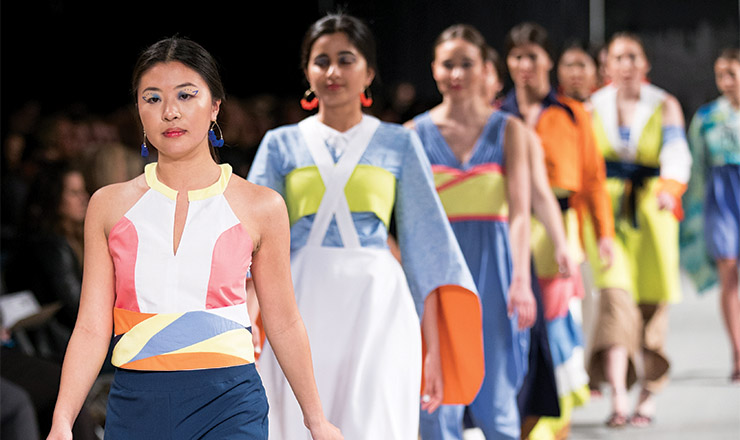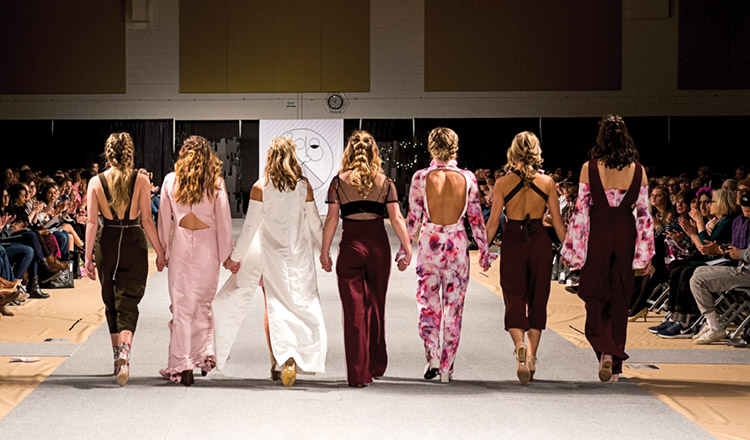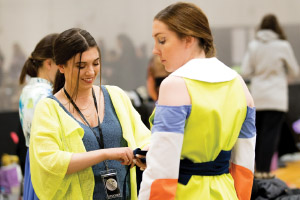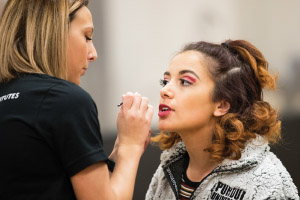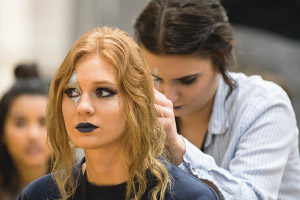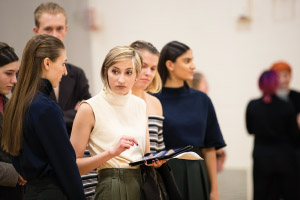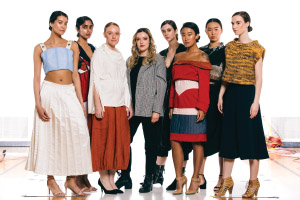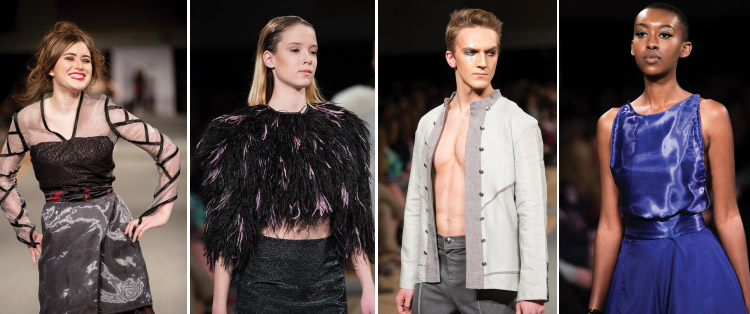Last apparel design and technology majors showcase collections in the final Purdue Fashion Show
The day has finally arrived. It’s five o’clock in the morning when the hair and makeup teams roll into the Cordova Recreational Sports Center and begin setting up the makeshift studio space where they will be camped for most of the day.
Designers arrive soon after, already exhausted from the previous day spent transforming the feature gym next door into a fashion runway and the previous evening running a dress rehearsal and finalizing their choreography. Not to mention the previous three months spent planning and organizing the final details of the show and the previous year spent designing and constructing their garments.
The past four years have all led to this day, when the last students majoring in apparel design and technology will showcase their capstone collections.
It’s the final Purdue Fashion Show.
“It was kind of surreal because the fashion show always seemed so far away,” says Emma Brown (HHS’18). “The days leading up to it were stressful and emotional. You realize your work will be on the runway in a few days. Everyone is going to see it.”
Brown was one of 18 seniors who debuted a collection in the fashion show held in April. Recent years saw upwards of 100 students enrolled in the program and participating in the fashion show. Students manage all the logistics that go into putting on the large-scale event, including securing the venue and production vendors, model recruitment and management, publishing and promotion, ticket sales, and even setting up every chair. Previous senior classes had the benefit of underclassmen in the program to assist in the execution of these tasks.
“We had to recruit a lot of volunteers this year,” Brown says. “But honestly even though in previous years you had extra hands — I used to help dress models, set up, and tear down — as a class we realized that this year it was just us and we just had to get it done. Everyone was working extra hard and extra fast, we didn’t even realize we were short underclassmen.”
Maintaining the high production value of the show was critical for Kristofer Chang Alexander (MS HHS’17), continuing lecturer in the Department of Consumer Science and one of two instructors, along with Susan Owens (HHS’94, LA’94), clinical assistant professor, who mentored the seniors through their final year.
“I didn’t learn that the program was closing until I came here,” Chang Alexander says. “Even though we didn’t have the same funding this year, I wanted these seniors to experience the same quality of show for their capstone collections as they saw when they were freshmen.”
He arrived on campus in the fall of 2014, the same semester as the senior class, to pursue a graduate degree in consumer science with a focus in apparel design and technology. For three years, he worked alongside these students, sharing lab space. “I’ve known them since they first started,” he says. “I am excited to see them graduate, but I’m also sad because it’s the last class.”
He can relate to the stress of putting on the fashion show. His 13-piece master’s collection walked the runway last year. “I think of myself as a mentor and a guide,” he says. “I would tell them ‘I know what you are going through. I know your experience. I know what it’s like to have to put a collection together. I know it’s doable.’”
Chang Alexander taught the fall senior collection class, where the students developed a minimum six-piece collection — detailing the target market, inspiration, mood board, color story, and textiles — and rendered sketches and illustrations for all of the looks. The students purchase their own textiles, and scholarships are available to help fund those materials, which can cost thousands. For her designs, Brown focused on sustainability, incorporating donated and dead stock fabrics that otherwise would have gone to waste. She estimates she spent around $500 on the fabric for her collection.
“Strong design and execution come through no matter what fabrics are used,” Brown says. “Many students can’t afford expensive fabric, but their focal point and construction quality are clear regardless of cost of materials.”
Brown’s collection, titled “gärdn,” was inspired by her frequent visits to the Brooklyn Botanical Gardens during her junior year as part of the visiting student program at the Fashion Institute of Technology in New York City. “I was at peace as I wandered the gardens. I loved the colors of the plants and flowers, and I wanted to incorporate that,” Brown says. “I drew inspiration from the way plants grew, their silhouettes, the floral shapes.”
The morning of the fashion show, just before she was to dress her models, one of Brown’s zippers broke. Another designer helped sew the model into her dress. “I was running around a lot that morning, but the environment was so positive because everyone is in the same place as you are,” Brown says. “Everyone is feeling the stress of the day, so we’re all there to help each other.”
Strong Foundation
This was the first year that Nancy Strickler (HHS’73, MS HHS’77) wasn’t backstage assisting students with last-minute fixes. She retired in May 2016 as clinical associate professor of consumer sciences and retailing after 25 years as lead instructor for the apparel design and technology program.
“I felt a great sense of pride to see how they pulled it together, knowing I wasn’t involved,” Strickler says. “Executing the same finished product with fewer people associated with the program, that alone was an achievement for this group. I’m so glad they could graduate with the fashion show as a part of their college experience and know it was just as strong of a show as it had been when they were freshmen.”
Informal fashion shows were held in the auditorium of Matthews Hall when Strickler joined the faculty in 1992, but it wasn’t an annual event. She designed the courses where students plan and execute the annual fashion show, which debuted in the Purdue Memorial Union in 2000. At that time, the major resided in the School of Consumer and Family Sciences. When the College of Health and Human Sciences was formed in 2010, it merged consumer sciences with programs in kinesiology, psychology, health sciences, and nursing, among others. Four years later, administrators announced the decision to discontinue the apparel and design technology major.
“I never received a direct answer as to why the decision was made,” Strickler says. “Ours was not a health-directed program, that was part of the understanding. We were a round peg trying to fit in a square hole. Our labs required a set space with expensive equipment that can’t be used outside of the department. Dedicating space to one use becomes expensive for a department.”
The lab spaces in Matthews Hall that house standard industrial machines, cutting tables, and dress forms have been in use for decades, and coursework in clothing and textiles has been taught on campus since the School of Home Economics was founded in 1905. The Home Economics Building opened in 1923 and was later named for Mary L. Matthews (HDR E’53), the first dean of the School of Home Economics. In tribute to Strickler, an award recognizing a fashion design student who demonstrated strong academic skills, leadership, and community service was named in her honor this year.
“It was bittersweet,” Strickler says. “It was sad knowing it was the end, but I had 26 years of being proud of that department and the other professionals I worked with. The future objectives of our college were different. Things change. Times change. Directions for organizations change and that’s what happened to us.”
Industry Standards
Beginning this fall, students interested in studying apparel construction, pattern making, draping, computer-aided design, and fashion illustration can major in retail management with a concentration in apparel design and technology. The five courses that compose the concentration will be taught by Chang Alexander, as Owens retired this year. Although Chang Alexander hopes to resurrect the fashion show, there are no plans to hold one of the same caliber students have grown accustomed to in recent years. It’s an expensive undertaking, between $25,000 and $30,000 to produce. The Purdue Fashion Association held fundraisers to help cover expenses.
“Fashion shows are part of the industry in any city,” Strickler says. “There has to be a way to show your work. By producing a fashion show, our students learned how to make decisions, set goals, work with time management and deadlines. They are much more professionally connected to what they want to do in the future than they would have been only working in a classroom.”
Students had the freedom to design a collection around whatever theme or inspiration they chose, and some opted to design a theatrical costume collection rather than ready-to-wear. However, their work couldn’t be too avant-garde; it had to be marketable.
“I wanted these students to experience a professional runway show,” Chang Alexander says. “We have always taught industry standards. The proof of the success of this program lies in our alumni.”
Ann Day (HHS’80), co-owner of Day Furs and Luxury Outerwear in Carmel, Indiana, established an excellence in construction award, which she presented each year during the fashion show. Other alumni work for major labels in New York, design costumes in California, have careers at nationwide clothing retailers, or launch their own fashion lines.
“Even though it is a really strong program and can hold its own, so many people didn’t even know Purdue offered fashion design,” Brown says. “I feel incredibly lucky to have made the cut for this program and be a part of the last class for the major. So many alumni have landed such great internships and jobs from the success they’ve had in this program. I want to carry that on and let people know that students come to Purdue for fashion design.”

